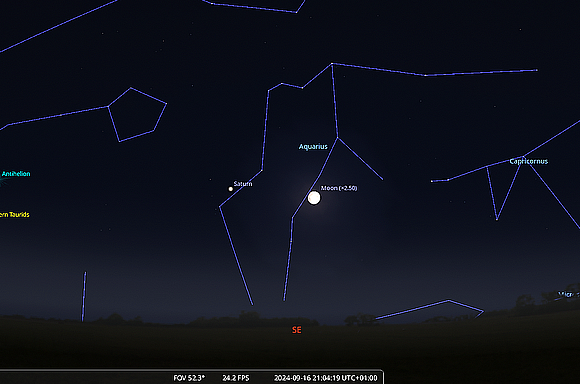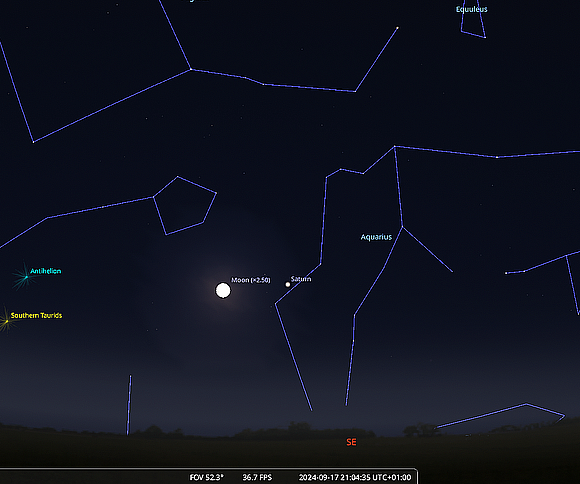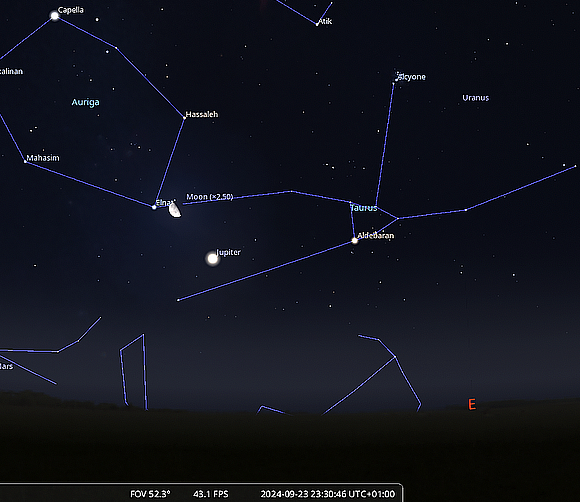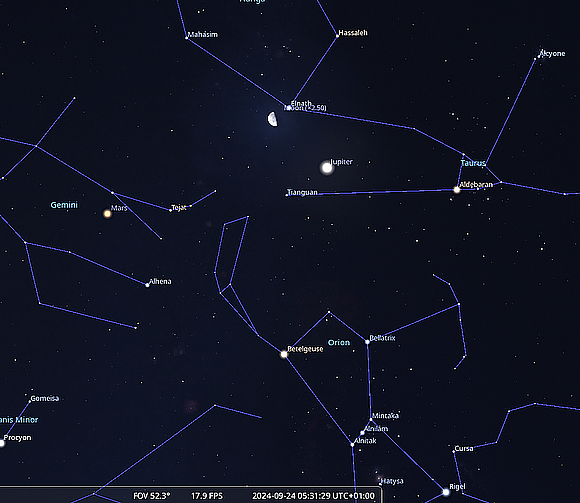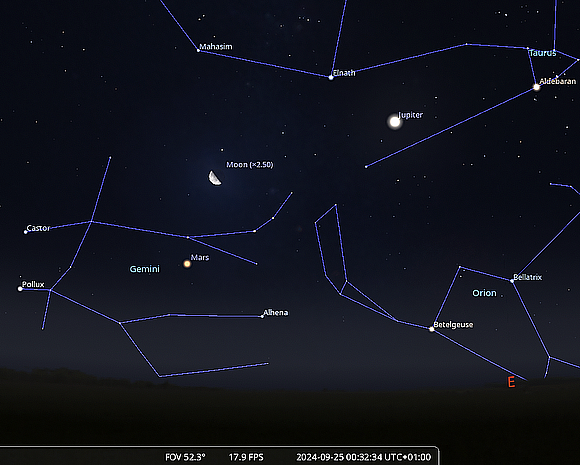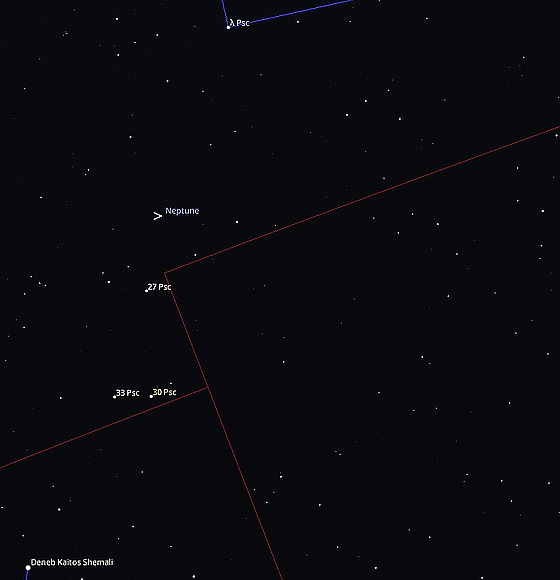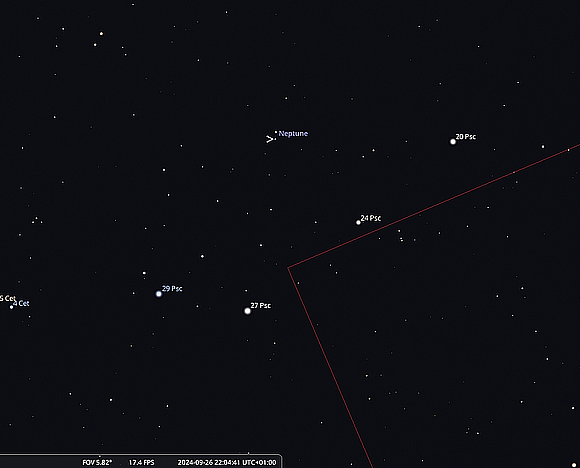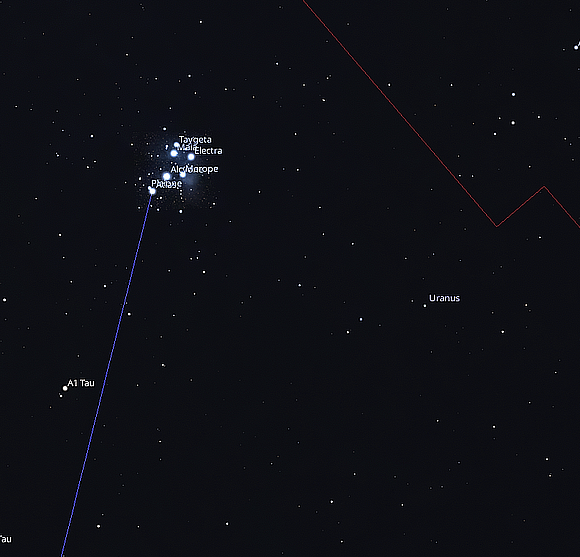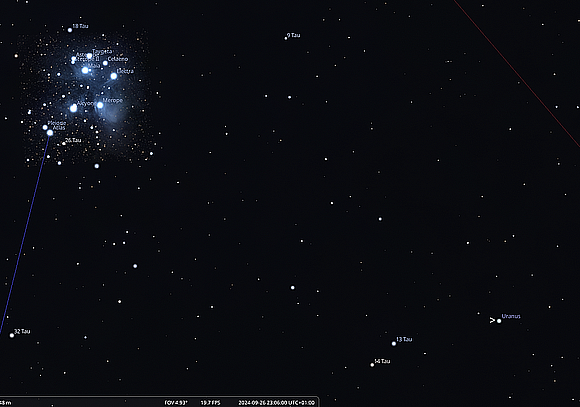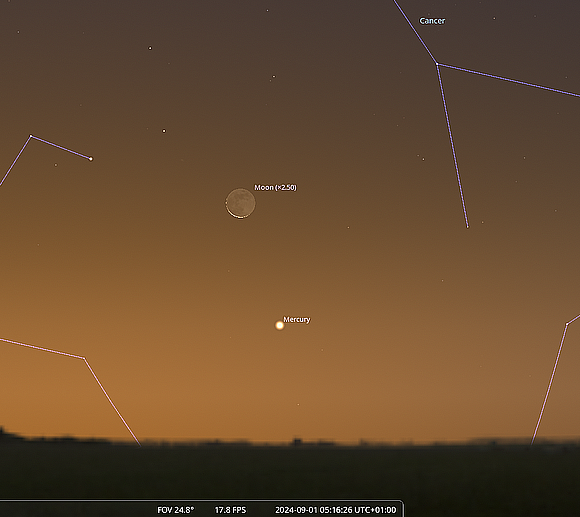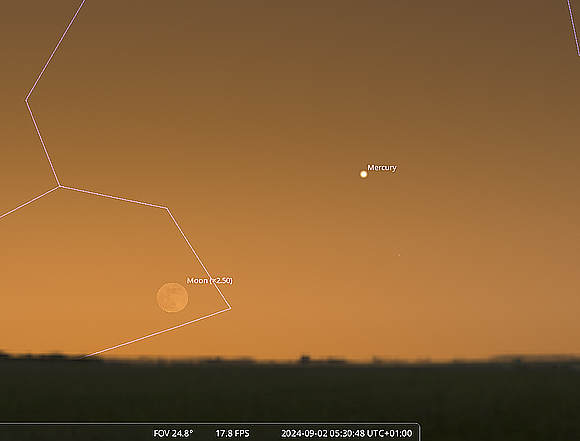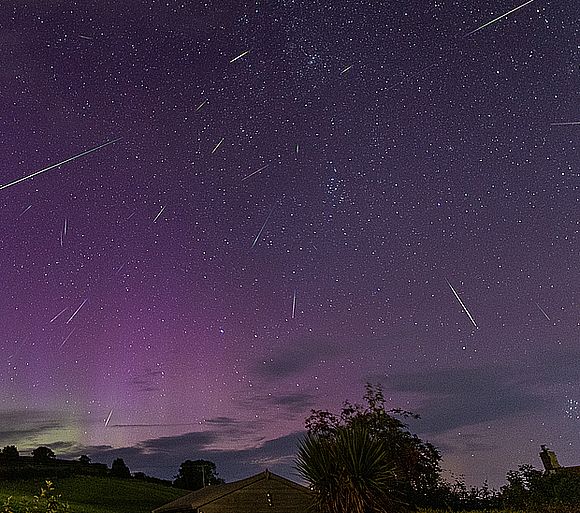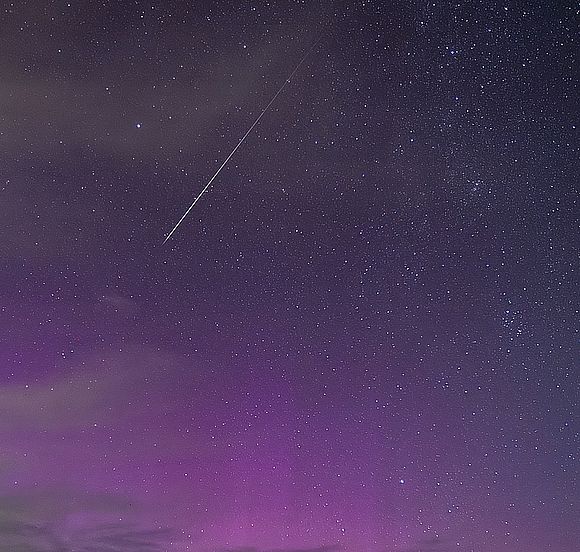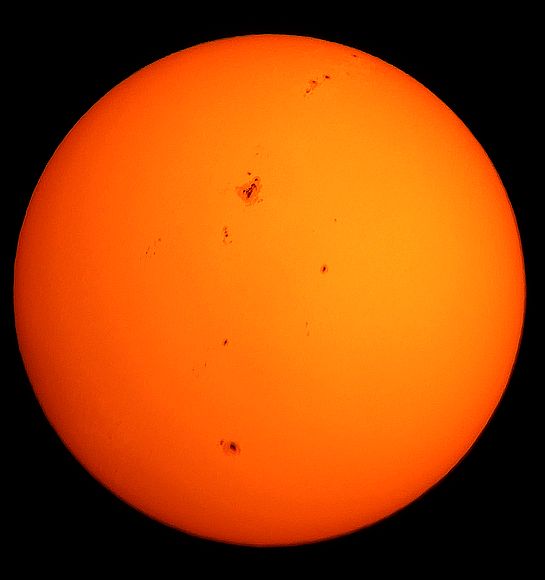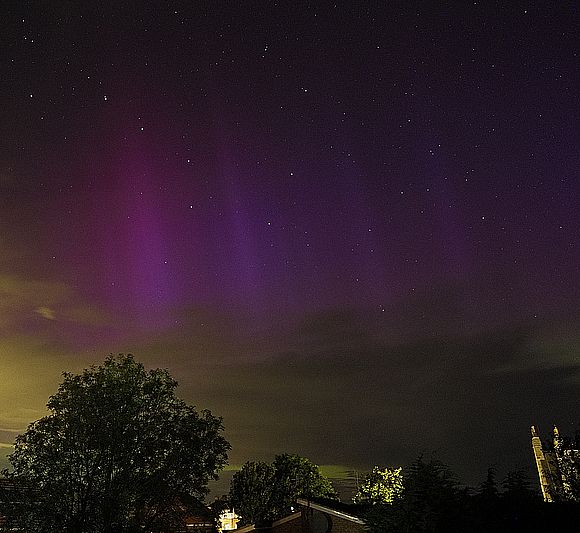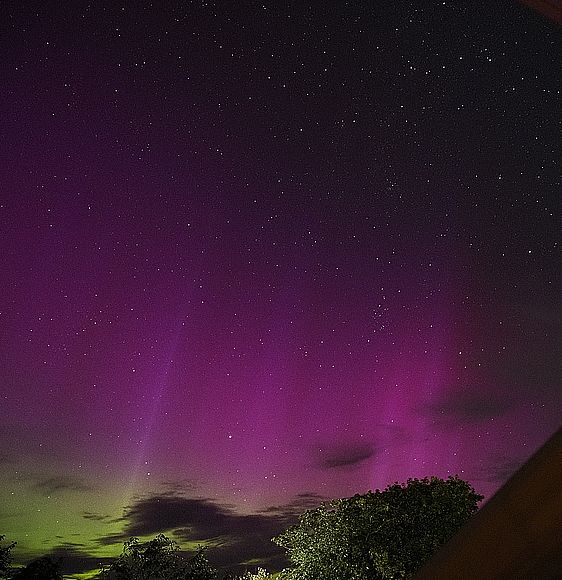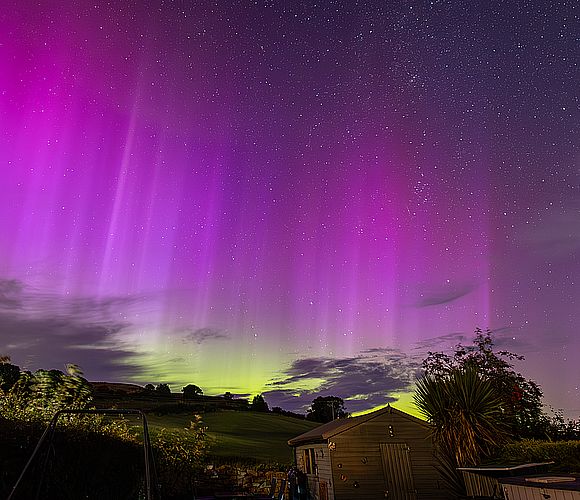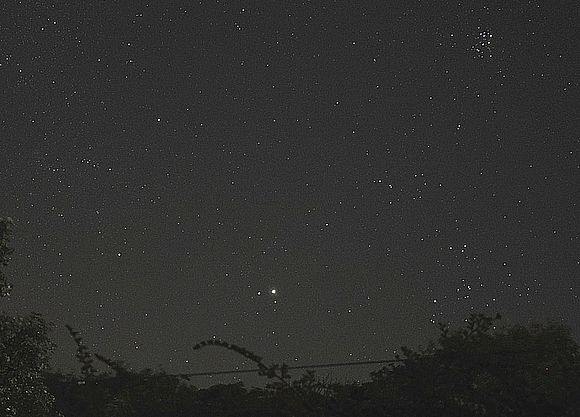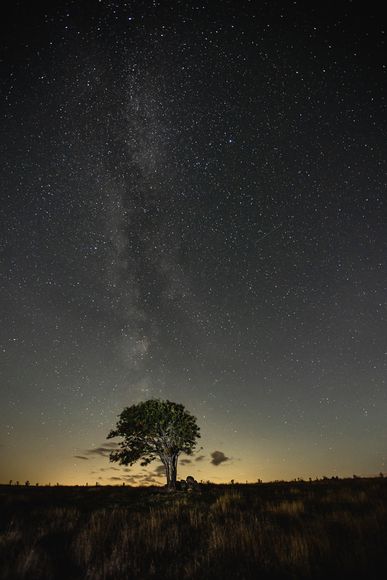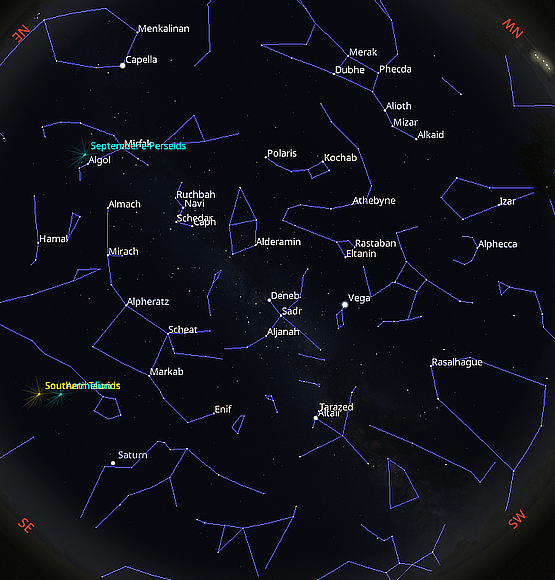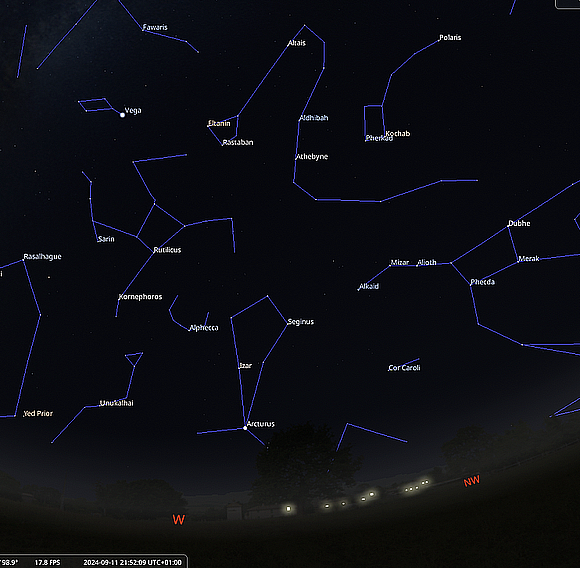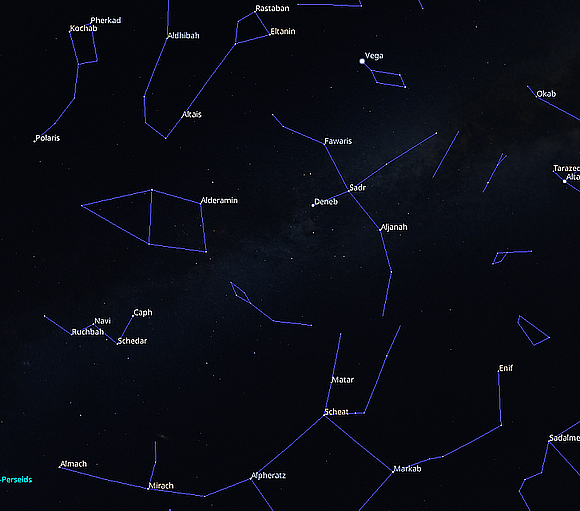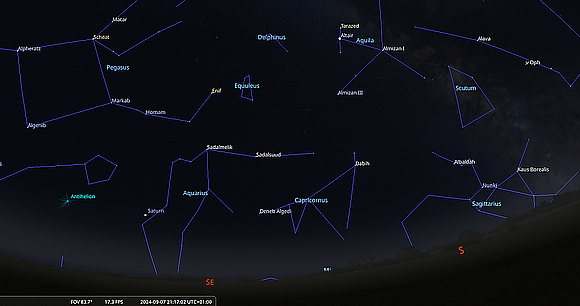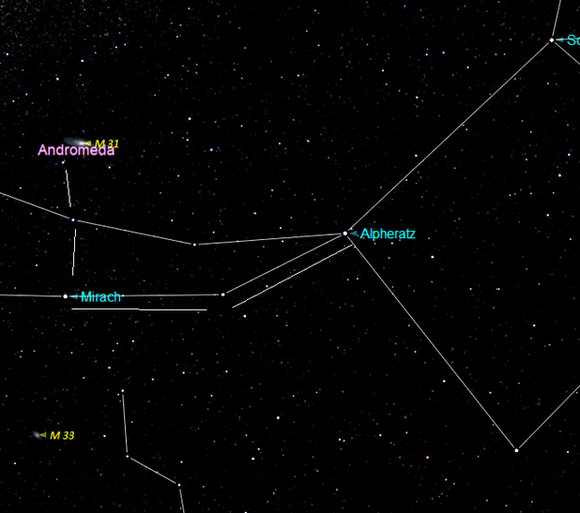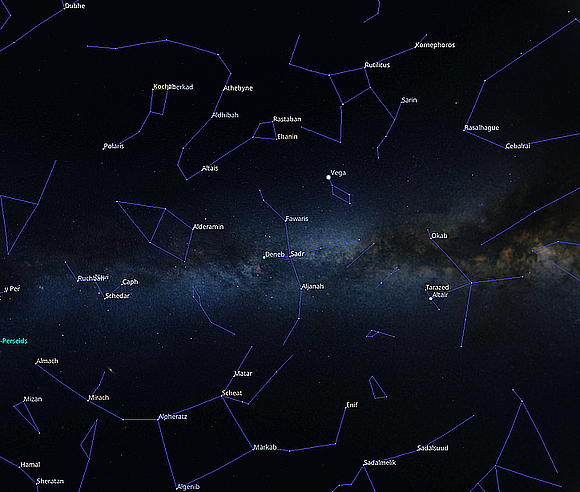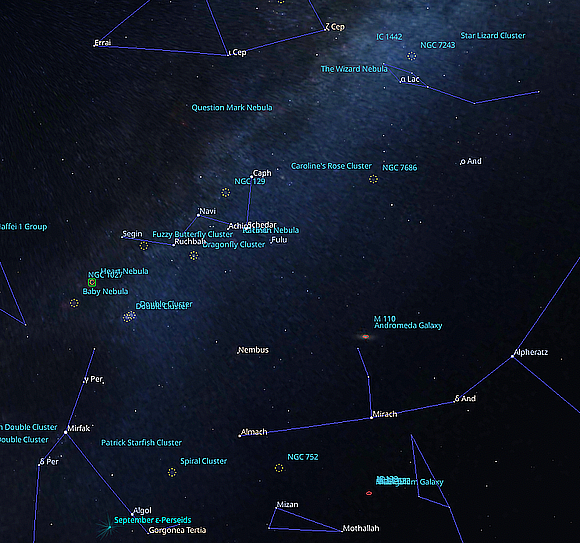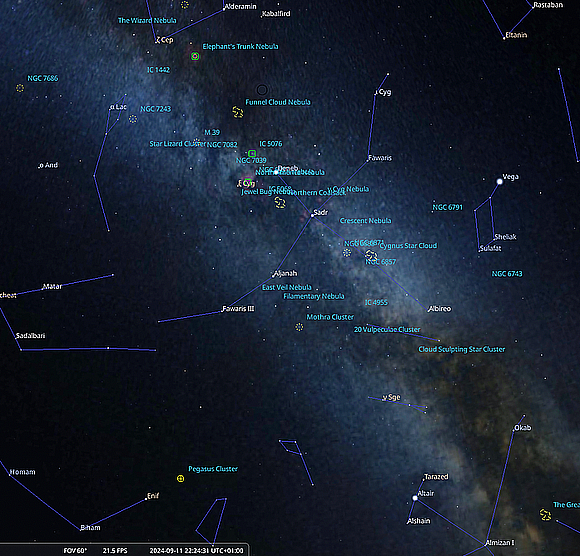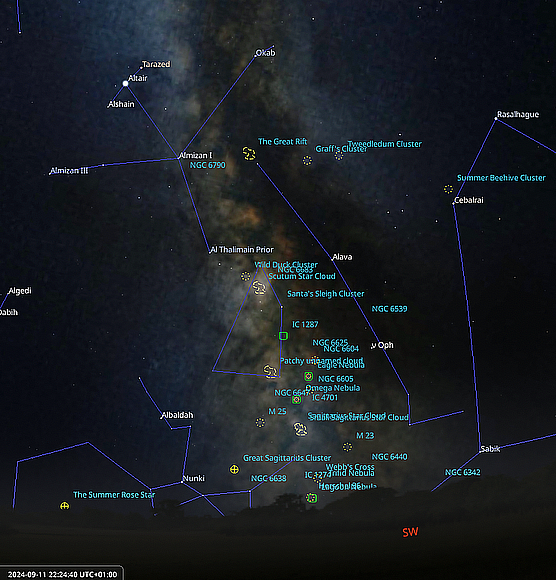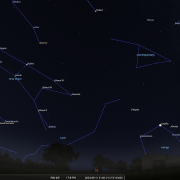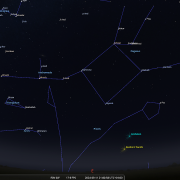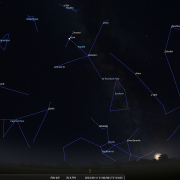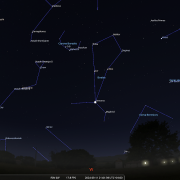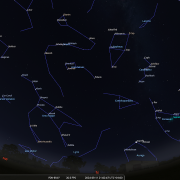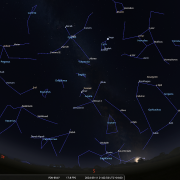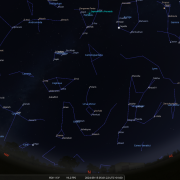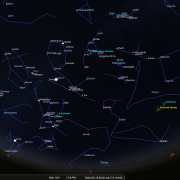In this month's Sky Notes:
- Planetary Skylights
- September Meteors, Sunspots, Aurora, Conjunction reports
- Autumnal Equinox
- September Night Sky
- September 2024 Sky Charts
Planetary Skylights: A Brief Guide to September's Night Sky
Following a hectic month of planetary highlights in August, September has two planets reaching opposition; Saturn and Neptune; Jupiter and Mars become better placed for late evening observation. Mercury undergoes its most favourable morning apparition of the year and Uranus continues in the direction of the Pleiades.
 Saturn is first of the naked eye planets to rise, visible by 20:30hrs in early September and already on show by the month's end around 19:15hrs. Saturn reaches opposition on September 8th, visible from sunset to sunrise, culminating 28 degrees above the south horizon around 01:00hrs BST from our latitude. This is still 7 degrees below the celestial equator, which it crosses in 2026. Saturn is currently residing amongst the faint stars of Aquarius low to the southeast and is the most conspicuous object in that region. At magnitude +0.57 the creamy white hue of Saturn should appear reasonably steady with little discernible scintillation (twinkling). The magnitude will brighten to around +0.33 when Saturn culminates (highest elevation) above our southern horizon.
Saturn is first of the naked eye planets to rise, visible by 20:30hrs in early September and already on show by the month's end around 19:15hrs. Saturn reaches opposition on September 8th, visible from sunset to sunrise, culminating 28 degrees above the south horizon around 01:00hrs BST from our latitude. This is still 7 degrees below the celestial equator, which it crosses in 2026. Saturn is currently residing amongst the faint stars of Aquarius low to the southeast and is the most conspicuous object in that region. At magnitude +0.57 the creamy white hue of Saturn should appear reasonably steady with little discernible scintillation (twinkling). The magnitude will brighten to around +0.33 when Saturn culminates (highest elevation) above our southern horizon.
Through the eyepiece Saturn is often a magnificent sight, however, those expecting to view the glorious ring system may be disappointed to note that their orientation is less than 4 degrees with detail such as the dark Cassini division glimpsed in larger instruments only - toward the extremities of the rings. This scenario continues (after a slight increase to 5 degrees later this year) with Saturn reaching ring plane crossing in March 2025, the rings then appearing practically edge on. Under good seeing conditions (post-midnight) instruments as small as 77mm (3") will reveal the rings - such as they are.
Of Saturn's many moons (now officially 146) in orbit about Saturn, just 8 are visible to 'amateur telescopes' although Rhea, Tethys, Dione and Iapetus are most often glimpsed in instruments above 200mm (8"). Titan, Saturn’s largest moon by far is always apparent in modest instruments as a bright speck of light, orbiting around Saturn roughly every 16 days. By late September there will be an observing window of at least 4 hours in which Saturn lies above 20+ degrees, i.e. in better 'seeing' airs, a period which is set to increase. Look for the gibbous Moon to the right of Saturn on Sept 16th and to the left the following evening.
 Jupiter is the next planet to rise after trading places with Mars last month. It trails Saturn by 90 minutes or so on the ecliptic, becoming readily noticeable in the ENE by 22:00hrs at the month's end. Residing in the heart of Taurus - the bull, Jupiter is very conspicuous to the naked eye at mag -2.3 increasing to -2.5 by the month's end. Jupiter is also gaining elevation, climbing to 50 degrees above the south horizon by dawn at the start of the month to almost 60 degrees by the end of September, well clear of turbulent air and bad seeing for at least 4 hours of observations.
Jupiter is the next planet to rise after trading places with Mars last month. It trails Saturn by 90 minutes or so on the ecliptic, becoming readily noticeable in the ENE by 22:00hrs at the month's end. Residing in the heart of Taurus - the bull, Jupiter is very conspicuous to the naked eye at mag -2.3 increasing to -2.5 by the month's end. Jupiter is also gaining elevation, climbing to 50 degrees above the south horizon by dawn at the start of the month to almost 60 degrees by the end of September, well clear of turbulent air and bad seeing for at least 4 hours of observations.
Through the eyepiece Jupiter’s oblate globe is a whopping 42 arc-seconds in diameter, making for pleasing observations even with a small telescope. Look for the darker banding, great red spot, and attendant Galilean moons near the disk. As the Jovian system revolves quickly (Jupiter itself in less than 10 hours) cloud features and disposition of Galilean moons constantly evolve. Moon shadow transits can also be witnessed on the disk of Jupiter, the most observer friendly ones will be highlighted over the coming months. September has just a couple, the 25th, when the shadow of Io is visible on the disk around 22:00hrs BST, along with the GRS, which will also be visible on the 27th at 22:30hrs. Overnight of Sept 23/24th look for a last Qtr. Moon in conjunction with Jupiter.
 After last month’s spectacular conjunction with Jupiter, Mars starts the month 8 degrees in separation from Jupiter and ends it over 22 degrees, moving into the heart of Gemini the constellation following Taurus. Rising shortly before midnight as September begins, Mars is rapidly gaining elevation reaching 50+ degrees above the SE horizon at dawn by the end of the month. Mars will then be at mag + 0.5, more conspicuous than Castor or Pollux, the chief stars in Gemini located to the left.
After last month’s spectacular conjunction with Jupiter, Mars starts the month 8 degrees in separation from Jupiter and ends it over 22 degrees, moving into the heart of Gemini the constellation following Taurus. Rising shortly before midnight as September begins, Mars is rapidly gaining elevation reaching 50+ degrees above the SE horizon at dawn by the end of the month. Mars will then be at mag + 0.5, more conspicuous than Castor or Pollux, the chief stars in Gemini located to the left.
Through the eyepiece Mars still exhibits a disappointingly small disk barely more than 7 arc-seconds in diameter and features will be difficult to distinguish using apertures under 250mm (10") although the large wedge shaped Syrtis Major feature should be visible from September 24th. The waning Qtr. Moon lies above Mars around midnight on September 24/25th with Jupiter off to the right. The following day the Moon lies left of Mars, you may catch then rising together shortly before midnight of the 25th. Mars comes to opposition in January, so it will be a few months yet before it becomes more noticeable in the evening sky.

 Neptune and Uranus are both now visible throughout late evening and overnight, although Neptune is better placed, reaching opposition on Sept 19th. Neptune resides approximately 15 degrees eastwards of Saturn, below the faint loop of stars marking the western fish of Pisces in particular lambda Piscium (mag 4.5). The nearest binocular 'bright' stars are the 5th magnitude 20, 24, 27 and 29 Piscium stars, all are between 1.4 & 2 degrees below Neptune. Neptune itself is at 7th magnitude appearing as a tiny 2.4 arc-second blue-grey disc through the eyepiece. To glimpse this requires at least a 100mm (4") aperture at 100x magnification, a 200mm (8") aperture will readily reveal it. If you know exactly where to look Neptune is even visible as a speck in humble 10x50 binoculars, but you will require a good star chart.
Neptune and Uranus are both now visible throughout late evening and overnight, although Neptune is better placed, reaching opposition on Sept 19th. Neptune resides approximately 15 degrees eastwards of Saturn, below the faint loop of stars marking the western fish of Pisces in particular lambda Piscium (mag 4.5). The nearest binocular 'bright' stars are the 5th magnitude 20, 24, 27 and 29 Piscium stars, all are between 1.4 & 2 degrees below Neptune. Neptune itself is at 7th magnitude appearing as a tiny 2.4 arc-second blue-grey disc through the eyepiece. To glimpse this requires at least a 100mm (4") aperture at 100x magnification, a 200mm (8") aperture will readily reveal it. If you know exactly where to look Neptune is even visible as a speck in humble 10x50 binoculars, but you will require a good star chart.
Uranus lies in Taurus approximately 5 degrees lower right of the Pleiades star cluster. At mag +5.8 Uranus is technically visible to the naked eye and is seen as a speck in binoculars. Apertures of 80mm plus (3+") are required to spot the tiny 3.7-degree disk, soft green-grey in hue. The nearby pairing of 13 and 14 Tau (both 5th magnitude stars) lay one degree to the left of Uranus.
 Mercury has its best dawn apparition of the year in September, pulling rapidly out west of the Sun reaching greatest elongation on Sept 5th some 18 degrees and an elevation of 10 degrees above the ENE horizon. As September commences Mercury will be approximately 8 degrees above the ENE horizon around 05:30hrs BST - roughly 40 minutes before sunrise. At magnitude +0.56 Mercury will be readily visible in binoculars and should be visible to the naked eye once picked up. As with all morning apparitions Mercury will appear faintest at the start, brightening as the apparition progresses. By the 5th Mercury has brightened to mag - 0.23, then to mag -1.13 by September 15th by which time it will only be 5 degrees above the horizon. A very old Moon (in fact almost New) will be a challenging target approximately 5 degrees above Mercury on Sept 1st and even more so the following morning 7 degrees lower left of Mercury. A typical 7 x 50 binocular field is around 7 degrees.
Mercury has its best dawn apparition of the year in September, pulling rapidly out west of the Sun reaching greatest elongation on Sept 5th some 18 degrees and an elevation of 10 degrees above the ENE horizon. As September commences Mercury will be approximately 8 degrees above the ENE horizon around 05:30hrs BST - roughly 40 minutes before sunrise. At magnitude +0.56 Mercury will be readily visible in binoculars and should be visible to the naked eye once picked up. As with all morning apparitions Mercury will appear faintest at the start, brightening as the apparition progresses. By the 5th Mercury has brightened to mag - 0.23, then to mag -1.13 by September 15th by which time it will only be 5 degrees above the horizon. A very old Moon (in fact almost New) will be a challenging target approximately 5 degrees above Mercury on Sept 1st and even more so the following morning 7 degrees lower left of Mercury. A typical 7 x 50 binocular field is around 7 degrees.
Aim a telescope at Mercury and the view won't be startling. Mercury is the solar system's smallest planet (in fact the moons Ganymede and Titan are larger), but if 'seeing' is reasonable you should notice the change in phase shape and angular size over the course of the apparition from a 29% 8 arc-second phase on Sept 1st, to an 83% 5.5 arc-second phase by the 15th. Mercury can be notoriously difficult to spot, until you do spot it! Start to view around 50 minutes before Sunrise (around 05:20hrs BST). Conditions will become too bright 25 minutes before sunrise.
September Meteors, Perseid & Aurora Reports
There are no major noteworthy meteor showers in September; however, you may spot a few Piscids which have two peaks: the 8th and the 21st. Rates are low, with only 6 or 7 per hour at best, barely more than sporadic levels. As with all meteor showers early morning viewing will be best. Moonlight will interfere for the second date.
Last month’s Perseid shower peak coincided with reasonably clear skies; Mark, John and Keith met up on the West Cliff late on Aug 11th and ended up on the cliff zig-zags - escaping the strong breeze and light pollution. Cameras ready, they managed an hour from 11pm until midnight, taking numerous images of all parts of the sky available from the location. Although visually spotting 8 Perseids, somehow not one was captured on image! Follow up attempts were made the following evening, but again although seeing Perseid examples with the naked eye failing to capture one in the lens - at least Mark did. Richard Randle did capture many Perseids through time lapse imaging, compositing a fabulous image of them with aurora. He along with several other members did capture the aurora visible on the late evening of the 12th, the tail end of a strong display most of which was hidden in daylight. It was one of several ill-timed displays last month.
Perseid meteors; stunning composite of images taken in early morning hours of Aug 12th.
Image by Richard Randle. (Click for full image)
A bright Perseid meteor captured on the night of the 12th, aurora lower down.
Image by Richard Randle. (Click for full image)
Strong activity levels occurred on Aug 4th from 14:00hrs until 18:00hrs with levels ranging from 300 nanotesla to 600 nanotesla (red bar). This outburst would have resulted in a visible aurora from the UK being witnessed had it not being daylight...and cloudy! Yet another display was seen from parts of the UK not clouded out on Aug 27 midnight - 03:00hrs, we missed it here. With the Sun at solar maximum and increased solar activity present, warrants keeping close tabs on aurora alert sites, you never know when a display is on the cards.
Sunspot groupings on 2024-08-11-12:53hrs BST -
imaged with Lumix DMC TZ70 at eyepiece of 135mm Altair refractor
fitted with Helios Seymour solar glass filter.
Image Mark D (Click for full image)
Sunspot groupings on 2024-08-11-15:44hrs BST -
imaged with Lumix DMC TZ70 at eyepiece of 135mm Altair refractor
fitted with Helios Seymour solar glass filter.
Image Mark D (Click for full image)
The active Sun was also responsible for the Aurora witnessed on the August 12th, although the most intense display will have been hidden in daylight, the display was still visible late evening, before fading after midnight.
Aug 12th - 23:24hrs - looking north - through bedroom open velux window.
Image by Mark D using OM-1 - 15secs exposure. (Click for full image)
Aug 12th - 23:31hrs - looking northeast - bedroom open velux window.
Image by Mark D using OM-1 - 15secs exposure. (Click for full image)
And finally, last month's close planetary conjunction between Mars and Jupiter was captured by Mark and others, although the morning of closest approach was clouded out. The image below was taken the following morning - August 16th.
Mars and Jupiter (bottom centre) close together Aug 16th - 02:30hrs.
Image - Mark D (Click for full image)
And Mark completely missed the Saturn - Moon occultation in the early morning hours of Aug 21st. Zzzzzzzzzzzzzz unfortunately!
The Autumnal Equinox
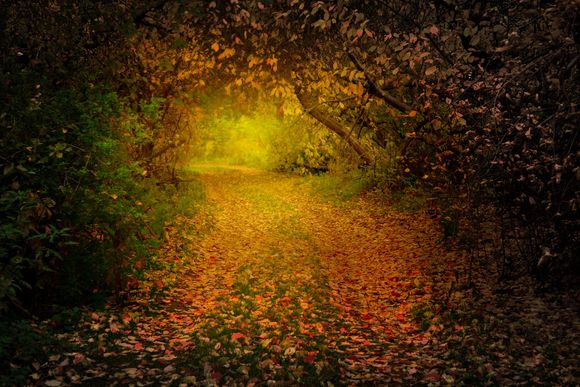
Meteorological autumn commences on Sept 1st in the northern hemisphere, whereas astronomical autumn does not officially commence until Sept 21st - the date of the autumnal equinox. Either way Autumn is rapidly approaching as the evenings draw in.
On the date of the autumnal equinox, from our perspective the Sun re-crosses the celestial equator and retreats southwards, arcing ever lower above the south horizon. At an equinox the Earth's poles are neither inclined toward, or away from the Sun, but are parallel to it. Hours of daylight and darkness will be almost equal across the globe. The northern hemisphere will continue to tilt away from the Sun with evenings becoming darker earlier, until the Sun eventually reaches the lowest position on the ecliptic - the winter solstice - around December 21st.
September Night Sky
The Milky Way - a highlight of early Autumn night skies
Image - by WDAS member Richard Randle (Click for larger image)
September is a month of change - summer to autumn, or dependant on what kind of summer has been had, it can sometimes feel the other way round!
For amateur astronomers should skies be clear, September is one of the best months in which to explore the night sky. Evenings are rapidly drawing in, with many stars visible by 21:15hrs BST at this latitude (Whitby - North Yorks) with deep sky objects – especially those of nebulous appearance apparent in the eyepiece by 22:15hrs. Should temperatures remain on the mild side, it can therefore be a pleasure to be observing. For UK observers September is also the month to fully appreciate the magical aspect of the Milky Way which will be at its most conspicuous to the naked eye from dark locations.
And so, to the sky, and as dusk falls five stars are first to emerge; Arcturus, in the west, the “summer trio” of Vega, Deneb and Altair – located overhead and midway up in the south, together with Capella low to the North. The celestial jigsaw puzzle is then gradually pieced together over the next hour as the fainter constellation stars emerge by 22:15hrs. Look to the west to locate brilliant amber hue of Arcturus in constellation of Boötes. Upper left of the Herdsman, note the appealing starry circlet of Corona Borealis - the Northern Crown, Alphecca or Gemma its lead star, the centre stone of the tiara.
Two large, ill-defined groups occupy much of the WSW aspect of the sky. The figure of Hercules sprawls across the higher regions of the west a little above Corona. It is best identified by the ‘keystone’ asterism. Below Hercules the larger and fainter outline of Ophiuchus extends down towards the SW horizon. High in the WNW, the familiar outline of the Plough, part of Ursa Major - the Great Bear is well placed. Follow the natural curve of the handle to locate Arcturus and Boötes, then utilise the ‘pointer’ stars in the bowl of the Plough to locate the pole star - Polaris, due north. Polaris marks the tail tip of the Little Bear - Ursa Minor. The brilliant star seen twinkling low above the north horizon is Capella in the circumpolar winter constellation of Auriga and not the north star as sometimes people think! The zenith (directly overhead) is occupied by the head of Draco, the body of which winds between the two bears.
Turn 180 degrees to due South, where Sagittarius - the Archer straddles the horizon. If skies are transparent look for the large asterism referred to as the ‘Teapot’, the outline of which resembles a more ‘angular’ type of pot slightly tilted as if pouring a cuppa! If you have a pair of binoculars or low powered telescope, spend some time exploring the magnificent star clouds and various nebulae located within Sagittarius. The summer ecliptic runs not far above the south horizon and along with Sagittarius much of the S - SE aspect is occupied by zodiacal constellations. Following the Archer are the stars of Capricornus - the Sea Goat. The aquatic theme continues low in the ESE with Aquarius - the Water Bearer and Pisces - the Fish, its inconspicuous stars meander down to and then back up from the east horizon. The planet Saturn currently resides in Aquarius.
High overhead to the South, extending down to the SSE, the constellations of the ‘summer triangle’; Lyra, Cygnus and Aquila dominate. A short distance above Altair in Aquila, note the small arrow shaped group of Sagitta together with the close-knit group of Delphinus situated to its left. Delphinus is one pattern that with a little imagination does resemble the outline of a dolphin leaping out of water. It is sometimes bizarrely known as ‘Jobs coffin’. Climbing up from the NNE horizon the great hero Perseus stands proud, whilst the distinctive “W” pattern of Queen Cassiopeia, sits on her throne above his shoulder. The eastern aspect of the sky is dominated by just a few constellations, particularly the winged horse Pegasus, which stands 2-3 hand-spans above the horizon. It is best identified by “the great square”, four stars arranged thus and enclosing an area of sky seemingly devoid of naked eye stars. Between Pegasus and Perseus, the chained princess Andromeda, daughter of Cassiopeia, stretches. Situated within the borders of Andromeda, our “sister” galaxy can be glimpsed with the naked eye on clear moonless nights.
To locate the Andromeda galaxy, star hop along a well-spaced chain of stars extending eastwards away from the upper left-hand star (Alpheratz) of the Square of Pegasus, marking the main body of Andromeda. Two stars along this chain at a star called Mirach, turn northwards, passing a further two fainter stars. Lying next to the second of these you should notice an elongated wispy patch of light, the Andromeda galaxy, a spiral system like our own. It is easily seen with binoculars, however if the sky is sufficiently dark and transparent, it is visible to the naked eye, making it the most remote object detectable without optical aid, a staggering 2.6 million light years distant. If you are not sure use the “averted vision” technique, i.e. - don’t look directly at it, but slightly to one side.
Below Andromeda sit two small constellations, Triangulum, below which lie the crooked line of stars marking Aries - the Ram. Along with the Andromeda galaxy and the Milky Way, the third spiral galaxy in our local group is in Triangulum -M33 (the other pinwheel galaxy in the sky), seen as a misty patch in binoculars or rich field telescopes. Finally, charging over the horizon in the ENE is Taurus the Bull, led by the exquisite open cluster of the Pleiades or Seven Sisters marking the bull's tail. The sight of the Pleiades reminds that Winter waits in the wings, but for the time being Autumn is about to take centre stage!
By late September the Milky Way is well placed for observation. Having allowed your eyes time to adapt (15 mins) to the dark oasis you have located, the Milky Way should be noticeable as a ghostly river of light dissecting the sky in a NE to SSW direction. Follow this milky stream from where it rises in the NNE through the constellation of Auriga, sweeping up through Perseus and into the ‘W’ pattern of Cassiopeia, where it's worth dropping anchor spending time exploring the star fields and plethora of ‘misty knots’ visible through binoculars.
Moving through Cepheus, the Milky Way then crosses overhead directly through the long axis of Cygnus, the Swan (sometimes called the Northern Cross) highlighted by the summer triangle luminary; Deneb, marking the tail of the Swan. Here the Milky Way divides into two channels which flow either side of a 'darker, elongated island' midstream. Known as the ‘northern rift’ this is an intervening dust cloud approximately 4 thousand lights distant which partly obscures the stellar multitude beyond.
Cascading down through Aquila, passing bright Altair, the Milky Way broadens before flowing into Sagittarius - straddling the SW horizon. In this direction nebulae and star clusters abound, rich pickings to keep the optical observer more than satisfied if skies are transparent. The galactic centre lies amidst the celebrated star clouds of Sagittarius, some 27000 light years away.
Revered by ancient civilizations as a divine water course or spiritual path, the true nature of the Milky Way has been understood for over a century. However, within the last few decades data obtained from across the electromagnetic spectrum from varied sources has reshaped our understanding of the galaxy. It would appear the Milky Way galaxy is not the classic multi-armed spiral with a central hub structure once thought; (like a Catherine wheel on bonfire night). Our galaxy is a barred spiral galaxy over 120,000 light years in diameter with just two major arms and several lesser ones. The central bar consists of stars orbiting in highly elliptical paths and is approximately 28,000 light years in length, bulging at the centre. At the very centre lurks a massive black hole of some 4 million solar masses. Our Sun is located on the edge of a quiet stellar neighbourhood midway between two major arms known as the Orion spur, some 26,000 light years from the galactic centre. The arms themselves are approximately 1,500 light years thick, the nearest sections of which lie some 6,500 light years away.
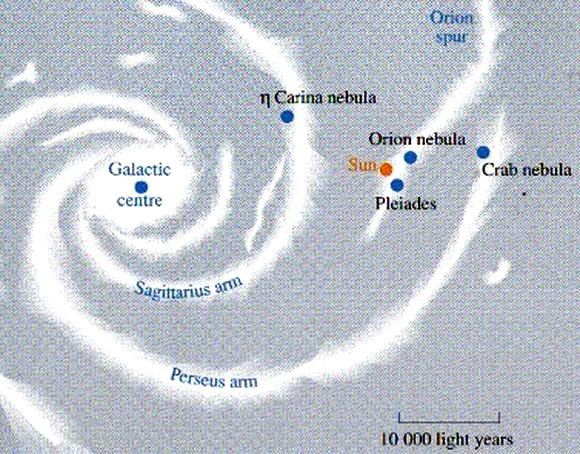
Our Sun's location in the Milky Way.
Our stellar citadel is vast and may contain approximately 200 billion other suns and over a trillion planets (estimates vary), and yet all that accounts for just 6 percent of our galaxy's mass, the rest taking the form of dark matter. Amongst the detritus of our hectic lifestyles, people rarely can, or are able to, afford time to fully appreciate the majestic and infinite starry sky. This month, make time and take a leisurely and awe-inspiring cruise down the Milky Way stream.
September Sky Charts.
Additional Image Credits:
- Planets and Comets where not otherwise mentioned: NASA
- Sky Charts: Stellarium Software and Starry Night Pro Plus 8
- Log in to post comments

